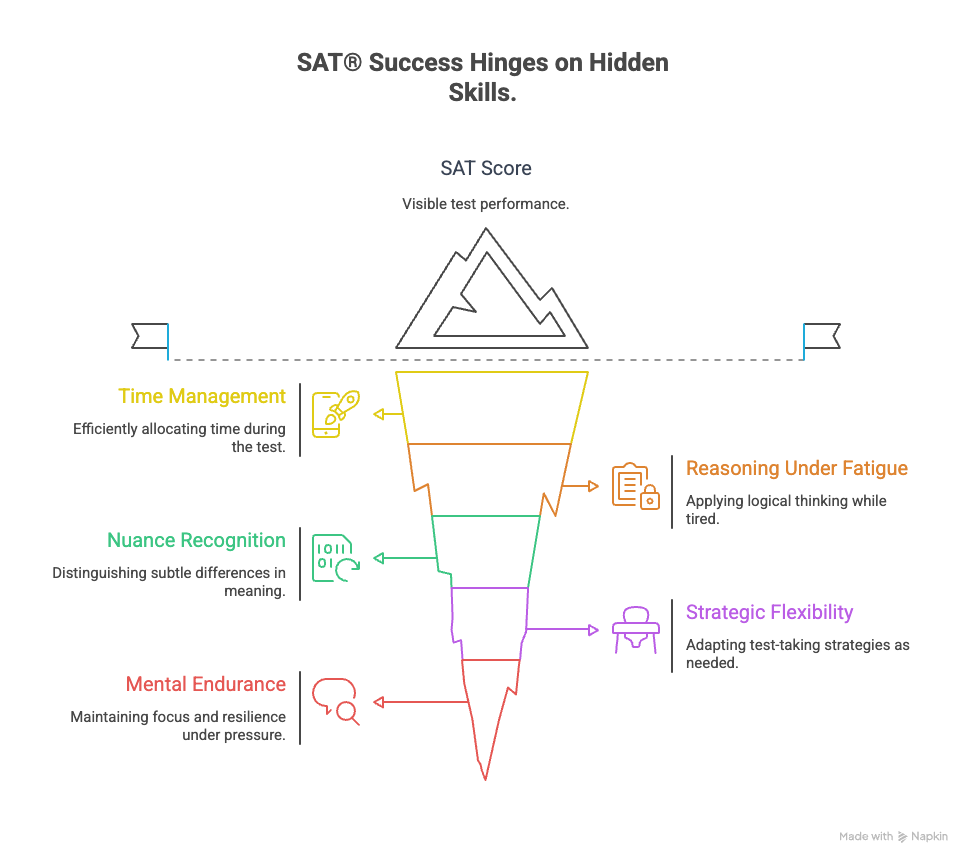You open your laptop to start your SAT® prep. Two minutes later, you're on your phone. You scroll through reels that say, “lock in,” while the timer app you downloaded last week gathers dust. You want to care. You do. But your brain keeps slipping sideways.
This isn’t laziness. This is modern adolescence under pressure and noise, especially when facing something as high stakes as the SAT® exam.
Let’s be honest about it. Then let’s figure out what helps students preparing for the SAT®.
The 6 Forces You’re Fighting in Your SAT® Prep (and How They Work Together)
This isn’t one problem. It’s a loop that often derails SAT® study plans.
1. Procrastination: The Emotion You’re Avoiding, Not the Task
You’re not putting off your SAT® study because it’s boring. You’re putting it off because it’s loaded with fear, expectation, pressure, or the dread of not being good enough to achieve your desired SAT® score.
Science check: Procrastination isn’t a time issue. It’s an emotion regulation issue. When a task triggers discomfort, your brain chooses short-term relief over long-term value (Pychyl & Sirois, Psychological Science, 2016).
Short-term fix for SAT® study blocks: Rename the task. “Study SAT® Math” becomes “open doc and type one bad line for SAT® practice.” This lowers emotional weight and makes you move.
Long-term fix: Learn to feel discomfort without obeying it. This is Stoicism 101. Marcus Aurelius said: “You have power over your mind- not outside events. Realize this, and you will find strength.”
You can feel overwhelmed and still begin your SAT® preparation.
2. Discipline: The Myth of Consistency You Keep Chasing for Your SATs®
You think discipline means waking up at 5 a.m. and grinding for 6 hours of SAT® review. That’s not discipline. That’s a fragile performance that breaks under stress.
Real discipline is boring. Quiet. Uneventful. It’s the habit of doing the minimum required thing, even on bad days, to keep your SAT® prep on track.
Science check: James Clear calls it the “plateau of latent potential.”
You don’t see progress for a while but compound growth happens invisibly, until it doesn’t (Atomic Habits, 2018).
Short-term fix for consistent SAT® study: Shrink the habit. Don’t study for 2 hours. Study for 10 minutes. Then leave, or stay either is a win for your SAT® progress.
Long-term fix: Build a reliable floor, not an ideal ceiling. The point isn’t to be perfect. It’s to be there, consistently applying yourself to your SAT® prep.
3. Motivation: Why It’s Not a Fuel, It’s a Byproduct (Especially for the SAT®)
Waiting for motivation to start your SAT® review is like waiting for your phone to charge without plugging it in. You don’t feel motivated because your brain isn’t getting wins. You’re not seeing forward motion in your SAT® score improvement.
Science check: Dopamine isn’t just released when you achieve a goal. It’s released when you pursue one. The brain craves progress not completion (Berridge & Robinson, Trends in Neurosciences, 1998).
Short-term fix for SAT® study motivation: Break a big SAT® task into 5 checkpoints. Celebrate each. Give your brain the “I’m doing something” signal.
Long-term fix: Don’t chase passion. Chase direction. Discipline creates motivation. Not the other way around. This is key for sustained SAT® prep.
4. Stress: The Invisible Fog That Warps Perception (Affecting Your SAT® Performance)
Stress isn’t always visible. Sometimes it shows up as scrolling. Or zoning out. Or snapping at someone for asking you a question about your SAT® schedule.
Science check: Under chronic stress, the brain’s amygdala becomes hyperactive, increasing reactivity and reducing access to the prefrontal cortex the part that helps with logic and planning, crucial for SAT® problem-solving (McEwen, Annual Review of Neuroscience, 2007).
Short-term fix for SAT® stress: Try box breathing: Inhale 4. Hold 4. Exhale 4. Hold 4. It’s not a trend. It’s neuroscience.
Long-term fix: Build a weekly release valve: art, music, movement, journaling, or just shutting down the input for a day. The world doesn’t need you available 24/7. It needs you well, especially when preparing for a demanding test like the SAT®.
5. Social Influence: Everyone Else Looks Like They Have It Together (Your SAT® Peers)
You compare your SAT® prep to someone else’s highlight reel. You see their scores, not their breakdowns. You think you’re falling behind in your SAT® journey. And comparison turns into paralysis.
Philosophy check: Epictetus said: “We suffer more often in imagination than in reality.” We add pressure by assuming we’re the only one struggling with SAT® preparation. You’re not.
Short-term fix for SAT® comparison traps: Unfollow the noise. Mute without guilt. You don’t need constant proximity to other people’s curated ambition when you're focused on your SAT® goals.
Long-term fix: Choose a SAT® study community, not a feed. Talk to someone who’s also figuring it out. Progress becomes real when it’s shared, not performed.
6. Social Media: Not Just a Distraction A Neurological Hijack (Impacting Your SAT® Focus)
Every scroll delivers a dopamine hit. Your brain starts expecting stimulation every few seconds. Deep work, like SAT® practice, feels dull in comparison.
Science check: Platforms are designed to exploit variable reward systems, the same loop used in slot machines. That’s why you can’t stop your brain is being trained to seek novelty, not completion, making focused SAT® study challenging (Alter, Irresistible, 2017).
Short-term fix for digital distractions during SAT® study: Use a blocker during study sprints. Keep your phone in another room. This isn’t willpower. It’s design.
Long-term fix: Curate your feed. Follow accounts that teach, uplift, or offer silence. Let your inputs match your values and support your SAT® success.
.png)





